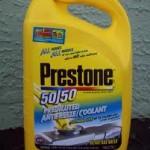How To Find a Coolant Leak In Your Engine
 So you have a coolant leak, or at least you think you might have a leak somewhere because you are constantly adding coolant to the radiator.
So you have a coolant leak, or at least you think you might have a leak somewhere because you are constantly adding coolant to the radiator.
If that is the case, then yes I would agree with you that the coolant is going somewhere and if you can’t find the leak with your naked eye then you need to use a pressure tester to help you find it.
Now, you can rent a cooling system pressure tester at your local auto parts store or you can pay a local mechanic to do it for you….probably less than $40.
You should also check the carpets under the passenger side of the interior of the vehicle up under the dash. Why? The heater core (the heater) is located inside your dashboard behind where the glove box is. When it leaks, it will drip coolant inside the vehicle onto the floorboard in that area.
The floor and or carpet will seem damp and have an oily feeling to it if your heater is leaking. You will usually smell a sweet smell and the windows will fog slightly with a residue…this is a sign of the coolant leaking into the cab of the vehicle.
You might also need to get under the vehicle to help look for coolant leaks along the bottom side of the engine, like from a freeze plug or water pump. And sometimes a water pump only wants to leak when the engine is off and has been sitting awhile. The water pump is usually located towards the front, facing the radiator on a rear wheel drive vehicle, and to the side facing the fender (usually driver side) on a front wheel drive vehicle.
Worst case scenario is you have an internal leak, inside the engine. This is usually due to a blown head gasket, leaking coolant into the cylinder. Usually the head gasket failure is a symptom of severe overheating, not the cause. So if the pressure tester can’t hold pressure AND you see no visible external coolant leak, you might have a head gasket issue internally.
To use a pressure tester yourself, watch this short video I found on Youtube.
Share and comment if you liked this
Austin Davis
